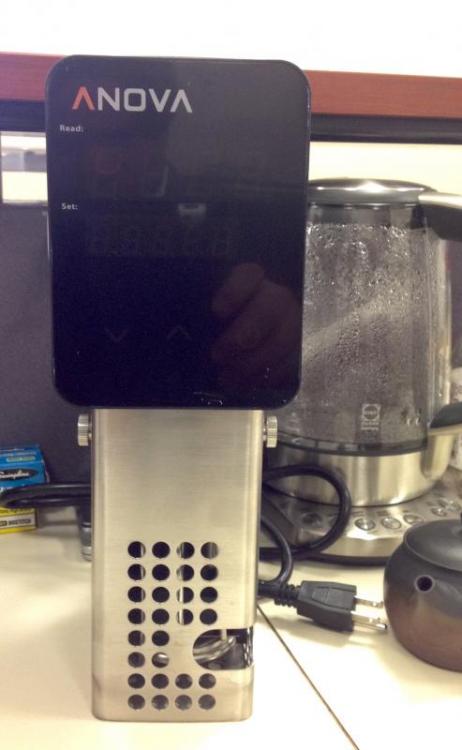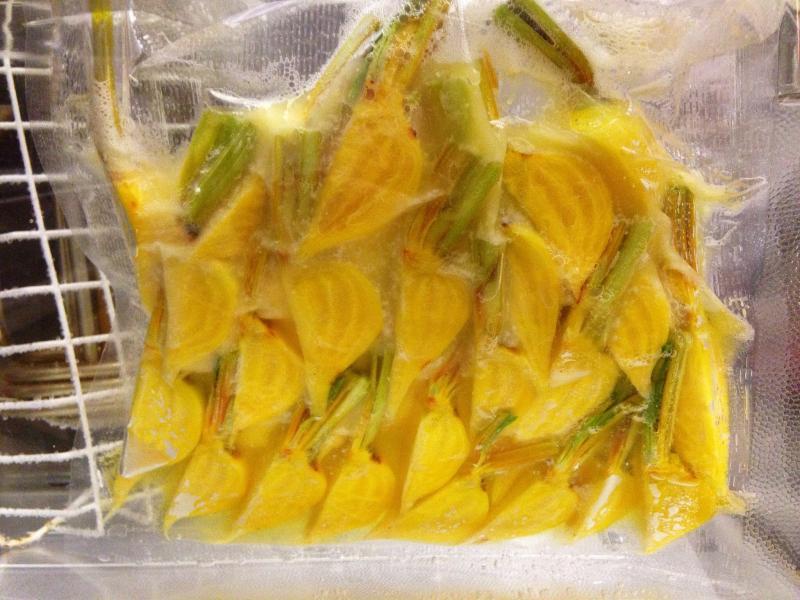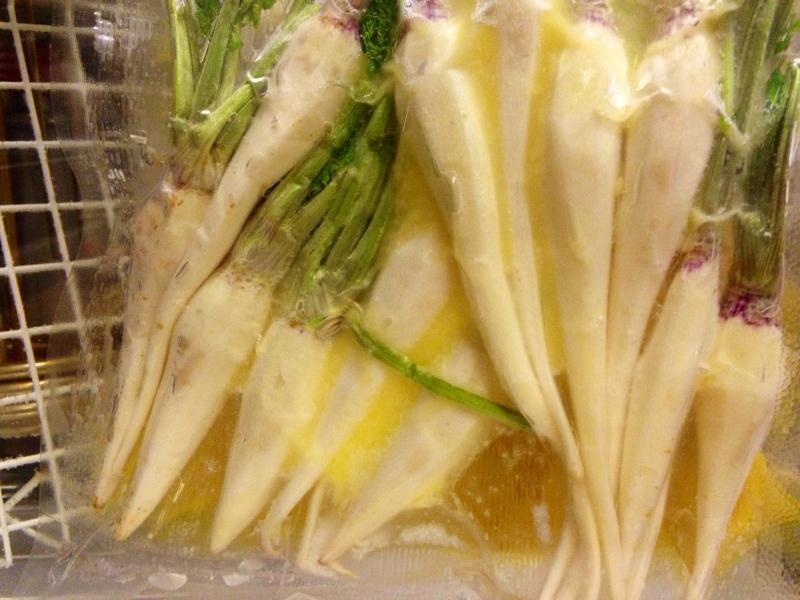-
Posts
11,151 -
Joined
Content Type
Profiles
Forums
Store
Help Articles
Everything posted by slkinsey
-
-
Generally speaking, when they say that a nonstick coating has some number of layers, they are talking about the number of times it has been sprayed with PTFE. For all intents and purposes, all nonstick surfaces are PTFE.
-

NYTimes Articles on Food, Drink, Culinary Culture 2013–
slkinsey replied to a topic in Food Media & Arts
The problem is that there are far more restaurants that want to have a schmancy cocktail program than there are good cocktail creators willing to curate a list for them. Or, sometimes even worse, the kitchen or wine personnel figure they know enough about combining flavors to create their own cocktails despite having no experience or expertise in this field. The result is often a $16 glass of crap. -
I think the more important question is what it is that you might want to do in a four quart pan that would make paying for stainless lined heavy copper worth the expense? There are lots of potential uses for a 4 quart pan. But maybe not so many that actually derive a benefit from stainless lined heavy copper.
-
The temperature of the smoke will certainly impact the flavor imparted by the smoke, because various constituent gasses will precipitate out at different temperatures and once they are in liquid grim they will not permeate the meat.
-
FeChef, if you have any interest in exploring the unique effects of LT/LT sous vide techniques, you would be well-advised to heed paulraphael's advice. It's not just time and it's not just temperature, it's time at temperature. And, of course, it also depends on the properties and quality of the meat you're cooking. Boneless short ribs are the real thing where I buy them, but apparently this is may be an issue in your neck of the woods. So get some meaty bone-in short ribs and try them for 72 hours at 55C/131F. You may not care for the result, which is a completely novel taste/texture unachievable by other means, but it most certainly won't be dry and chalky. Overall, I find a lot of your temperatures on the high side for the length of time you are cooking. I'm a bit surprised you don't find your barbecue beef ribs a little dry after 24 hours at 68C/155F. I would be much more likely to go 12 hours at 70C or a lot more hours at 60C.
-

Shaking with water ice is not the best way to make cocktails at home
slkinsey replied to a topic in Spirits & Cocktails
I'm with those for whom this seems like a solution in search of a problem. The reason to chill and dilute drinks with water ice is because it's easy, fast, convenient and reliable within reasonable tolerances. Why would I want to bother keeping pre-diluted bottles of booze in the freezer? That seems like an awful lot of bother and wasted freezer space that could be occupied with, for example, glassware. I would have to be faced with pretty convincing evidence that the proposed method resulted in significant improvements in the end result before I would consider sacrificing the convenience of being able to decide what cocktail I want seconds before making it. The idea of freezing cubes of tomato juice or orange juice of whatever has some merits for long drinks, but again I'm not sure it would be worth the trouble. Is it really so bad if a Bloody Mary dilutes a bit if you're nursing it? More to the point, drinks rarely last long enough in my hand for this to become an issue. The one convincing case for flavored ice cubes I've seen is when the cubes release an additional flavor into the drink, causing it to evolve over time. It might be interesting to create a piece of ice that contained a different kind of booze inside that would eventually be released into the drink, but that would be a lot of work and needless to say a "special occasion" sort of thing. This statement speaks to much of what I am saying. Who says that would be the "superior way"? I'm willing to bet that it would be better the traditional way. -
This all looks great, Paul. Thanks for sharing it. I wonder if one thing might have helped: Would it be possible to take the 4 week aged chuckeye roast, open it up to remove all the tough connective tissue and big pockets of fat, reassemble and bond with Activa, then portion and cook as you have done? I suppose that would remove the possibility of the four hour "danger zone" cooking?
-
Those were for a thanksgiving dinner course. The great thing about preparing vegetables this way is that, just as with many proteins, you can chill the bags down in ice water, chuck them in the refrigerator for a few days, and either simply re-therm in a bath or caramelize them in butter for service. I've also experimented to good results with running all the trimmings through the juicer and using that liquid in the bag instead of butter, effectively making "carrots braised in carrot juice," "beets braised in beet juice," etc. Its also possible to, for example, put a little ginger and cumin in the bag for another layer of flavor.
-
-
I have had amazing results with peeled and quartered small golden beets at 85C for an hour with butter. They do have some tooth to them and aren't completely soft, but they are definitely cooked. What texture are you going for? If you want them just as soft as your three-hour oven braise, I'm not sure what there is to be gained through use of sous vide techniques. Certainly you can't expect a similar level of tenderness after cooking them at a much lower temperature for a shorter period of time. You might consider trying sous vide carrots, which are dead easy and wonderful, to see if the texture of vegetables prepared this way is agreeable to you. One way of describing this style is that it has a slightly toothy texture that would normally go along with "not quite cooked" flavors, except that it tastes fully cooked.
-
Ours lives on top of the refrigerator, and our ceilings are high enough that we have additional stuff on top of the microwave. So, effectively, it is using up zero space in our kitchen. 99% of our microwave use is for reheating and defrosting.
-
I like the All-American pressure canners by WACFO. I have a 921, which can process 19 pint jars or 7 quart jars. I bought in that size because I wanted a 5 gallon pressure cooker for making stock. If I were to do it again, I'd probably buy the 7.5 gallon 930, which can process 14 quart jars. On Amazon the 921 goes for $210 and the 930 goes for $280. On edit: I didn't realize the first post was from years ago. I am not aware of any stainless pressure canners.
-
It's a bit facetious to count ice or water as an ingredient, isn't it? Yes, yes, yes, we all know a Manhattan has water and bitters and a garnish. It's still considered a two-ingredient drink. Anyway, I have a fondness for equal parts two-ingredient (pre-dilution for the pedants) drinks, and two of my best creations are of this type: the Tango Sardo is equal parts Laird's bonded and Tramontis mirto, and the Kinsey Report (I didn't give it this name!) is equal parts Smith & Cross and Bonal. Both are good up or on a rock.
-
bostonapothecary, I don't disagree that these devices are ineffective. I'm just pointing out what they are designed to do. Anyway, I'm betting that bag-in-a-box vermouth would be just fine for periods up to a year of incremental use.
-
The idea of a vacuum device for a wine bottle is not to draw out gasses already dissolved in the liquid, but merely to remove as much oxygen as possible from the headspace. Really, when you think about it, the best design for something like vermouth would not be a bottle but rather a "wine in a box" concept so that no gas is introduced into the bottle from dispensing.
-
The NP Extra Dry is essentially a reintroduction of the old American version of NP that prevailed over here for many years.
-

"Modernist Cuisine: The Art and Science of Bread"
slkinsey replied to a topic in Cookbooks & References
I hope, hope, hope there is an extensive section on sourdough microbiology and techniques. -
The Leopold jigger is great, and effectively combines the best properties of jiggers and measuring cups. The only thing that's not great about them is that they can be messy to pour out of, and the bowl-shaped cups can cause the liquid to slosh right back out the other side if you pour into them too fast.
-

Copper vs Stainless Steel Clad Cookware: Is it worth the $$$?
slkinsey replied to a topic in Kitchen Consumer
If you don't want a responsive pan, then I wonder why you would spend the money on something like All-Clad. If you're using it to boil water, for example, thin stainless steel will do that just as well. If you're searing steaks, cast iron or carbon steel will do it better. The reality is that there aren't so many things where a straight gauge clad pan is needed. For the most part, this sort of design does best with things like reduction pans, saucepans that are actually used for sauce-making, small (1 - 1.5 quart) pans where heat coming around the sides might cause hotspots around the outside, and frypans if you don't want a seasoning metal. The point Paul was making is that five and seven layer pans are not thicker and heavier by definition. It all depends on the thickness of the layers. For example, let's say you have a "five layer pan" that has a 0.4 mm external layer of stainless, then a 0.05 mm layer of pure aluminum, then a 1.4 mm layer of aluminum alloy, then a 0.05 mm layer of pure aluminum, then a 0.04 mm internal layer of stainless. This might compare to a "two layer pan" that has 3.6 mm of aluminum on the outside with an interior lining of 0.4 mm stainless steel. The "five layer pan" not only has a thinner layer of thermal material compared to the "two layer pan," but has twice the amount of stainless steel. The fact is that pans promoted as having a zillion layers almost always involve some marketing mambo-jumbo where a micro-thin layer of bonding metal is counted as a "layer" in order to increase the layer count. -

Copper vs Stainless Steel Clad Cookware: Is it worth the $$$?
slkinsey replied to a topic in Kitchen Consumer
I use a gas stove. Regular old NYC apartment Crapmaster 9000. I'm not saying it is impossible to burn or scorch something in a heavy copper pan. But it is a lot easier to do it in other kinds of pans because of hot spots. The conductivity of copper and the thickness of the materials used means that my heavy copper pans are really good at spreading the heat around. As a result, the cooking surface doesn't really have any hot spots. To go to the opposite extreme, a thin stainless pan is going to be a lot hotter right where the flames are compared to the rest of the cooking surface. So, if you want to do a massive reduction of stock or keep a pan of oatmeal at a bare simmer for an hour, there are going to be parts of the thin stainless pan that are hot enough to burn the food. This won't be so in the heavy copper pan. Now, of course, you can mitigate this difference in performance by being super attentive and stirring constantly. But that's a huge hassle, and in cases where you are doing things like reducing a stock down to the consistency of thick syrup there is a very small margin for error. Personally, I want to be able to step away from a pot for a few seconds and not worry that I will end up ruining my reduction. At the same time, I don't want my reduction to take all day because I'm afraid to do it over maximum heat. -

Copper vs Stainless Steel Clad Cookware: Is it worth the $$$?
slkinsey replied to a topic in Kitchen Consumer
I think it depends a lot on what you want to get out of the piece and what the piece is. I don't see that a copper stockpot has all that much to offer over a heavy stainless stockpot with a thick aluminum pad. I have a probably unhealthfully large number of pans in every conceivable materials deployment and design scheme. Stainless-lined heavy copper is rarely needed for the things I like to cook. For example, if I want to just fry up a bunch of stuff at high heat I'm likely to reach for heavy carbon steel. But. For certain things there is simply no substitute, and a lot of them aren't all that fancy. I definitely have some copper pieces I might not buy if I had to do it again. A low casserole certainly I wouldn't. If I could get heavy carbon steel in the same shape as my copper frypan, I'd probably prefer that. But I would never give up my 11" curved sauteuse evasée, or my 2.75 quart curved saucepan or my 1.5 quart straight sauteuse evasée in heavy copper. I have various brands and iterations of fully clad designs in similar sizes, but I just wouldn't trust any of them to do something like an eight-fold reduction of a braising liquid down to a glaze without scorching. Even for something as quotidian as quickly toasting some steel cut oats and then slowly heating it covered on the stove until done, I am likely to reach for the copper because I can leave it unattended as long as I want without worrying that it will burn. I even once forgot about it for a few hours and while the bottom was dry and a bit browned, it was not burned and completely edible. Experience has taught me that this isn't possible with my clad stuff. Is it worth the money and the maintenance? It depends. It depends on what prices you're comparing it to. Certainly it's worth the money compared to All-Clad at retail. But these judgements are always subjective. Is a current model iPhone worth the money compared to a flip-phone or a phone running Android 2.2? For some it is, for some it isn't. This is where understanding your needs becomes important. If all you want to do is make and receive calls, there is probably no reason to spend the money on the iPhone. As for the maintenance, seasoned steel and iron is a lot less work but I can't say I think copper is less hassle than the stainless stuff. Sure, I can throw my fully clad and disk-bottom pans in the dishwasher, but they never get as clean that way as scouring by hand and I eventually have to work on them by hand to keep them really clean. Meanwhile, while it's true that it takes some extra work to keep a brushed copper exterior bright if you care about that sort of thing, it takes an equal amount of care to keep a polished stainless exterior shiny and scratch free if you care about that sort of thing. As always, it depends on what you want to do, how you want to do it, how much you're willing to spend, etc. -
There is, needless to say, also tons of liquid inside the vegetables used to provide additional flavor to stocks.
-
I make gigantic batches of stock in my pressure canner. It has a jiggle-weight pressure regulator (which you really want to have for canning) , but when I am making stock I simply set three quarters on top of the weight and regulate the heat source to keep it at 15 PSI on the pressure gauge.
-
Sous vide beef juice is is covered in the full Modernist Cuisine books. It's a pretty simple technique. Bag ground lean beef and cook SV for 1.5 hours at 90C. Yield is around 30% (meaning that 100 grams of lean beef will get you around 30 grams of beef juice). It's probably not included in MCAH because the low yield makes it too expensive for most home cooks. Osmazome is… okay, I guess. When it's produced as a byproduct of something I'm already making, I often chuck it into whatever sauce I'm making. But I wouldn't go to a lot of trouble and expense to make osmazome on purpose. IMO it doesn't hold a candle to jus, with all its Maillard flavors from intense browning and viscous mouthfeel from dissolved gelatin.






